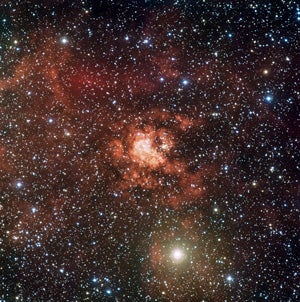A new image released by the European Space Observatory (ESO) shows the amazing intricacies of a vast stellar nursery named Gum 29. In the center, a small cluster of stars — called Westerlund 2 — has been found to be the home of one of the most massive double-star systems known to astronomers.
Gum 29 is a huge region of hydrogen gas. The intense radiation of the hot young stars at its center has stripped the region of its electrons. Astronomers call this an HII (pronounced “H-two”) region, and this particularly stunning example stretches out across space for more than 200 light-years. The object is the 29th entry in the catalogue published by Australian astronomer Colin Stanley Gum in 1955.
Embedded deep within the huge, nebulous expanse of Gum 29, the relatively little known cluster of Westerlund 2 is seen clearly in the center of this image. The latest measurements indicate that it lies at a distance of some 6,000 light-years from Earth, placing it towards the outside edge of the Milky Way’s Carina spiral. The cluster’s distance has been the subject of intense scrutiny in the past as it is one of the parameters needed to understand this intriguing object. Westerlund 2 is very young, too, at 1-2 million years old.
Previous observations have shown that two stars to the bottom right of the cluster are true leviathans. Together they form what is known as a double system. The two stars have masses of 82 and 83 times that of our Sun and rotate around each other in approximately 3.7 days. They are among the most massive stars known to astronomers.
Detailed observations of this intriguing pair also have shown that they are both Wolf-Rayet stars. These are massive stars nearing the end of their lives, expelling vast quantities of material as their final swansong. Observations made in Xrays have shown that streams of material from each star continually collide and create a blaze of X-ray radiation.










